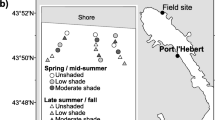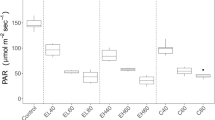Abstract
We developed light requirements for eelgrass in the Pacific Northwest, USA, to evaluate the effects of short- and long-term reductions in irradiance reaching eelgrass, especially related to turbidity and overwater structures. Photosynthesis-irradiance experiments and depth distribution field studies indicated that eelgrass productivity was maximum at a photosynthetic photon flux density (PPFD) of about 350–550 μmol quanta m−2 s−1. Winter plants had approximately threefold greater net apparent primary productivity rate at the same irradiance as summer plants. Growth studies using artificial shading as well as field monitoring of light and eelgrass growth indicated that long-term survival required at least 3 mol quanta m−2 day−1 on average during spring and summer (i.e., May-September), and that growth was saturated above about 7 mol quanta m−2 day−1. We conclude that non-light-limited growth of eelgrass in the Pacific Northwest requires an average of at least 7 mol quanta m−2 day−1 during spring and summer and that long-term survival requires a minimum average of 3 mol quanta m−2 day−1.











Similar content being viewed by others
References
Backman, T.W., and D.C. Barilotti. 1976. Irradiance reduction: effects on standing crops of the eelgrass Zostera marina in a coastal lagoon. Marine Biology 34: 33–40. doi:10.1007/BF00390785.
Boese, B.L., B.D. Robbins, and G. Thursby. 2005. Desiccation is a limiting factor for eelgrass (Zostera marina L.) distribution in the intertidal zone of a northeastern Pacific (USA) estuary. Botanica Marina 48: 274–283. doi:10.1515/BOT.2005.037.
Borde, A., R. Thom, S. Rumrill, G. Williams, D. Woodruff, J. Southard, and S. Blanton. 2003. Geospatial habitat change analysis in Pacific Northwest coastal estuaries. Estuaries 26: 1104–1116.
Brush, M.J., and S.W. Nixon. 2002. Direct measurements of light attenuation by epiphytes on eelgrass Zostera marina. Marine Ecology Progress Series 238: 73–79. doi:10.3354/meps238073.
Bulthuis, D. 1996. Effects of short-term light reduction during different seasons on survival of intertidal and subtidal eelgrass, Zostera marina, in Padilla Bay, Washington. Final report for NOAA/SRD Award #NA27OR0216, Padilla Bay National Estuarine Research Reserve, Mount Vernon, Washington.
Burke, M.K., W.C. Dennison, and K.A. Moore. 1996. Non-structural carbohydrate reserves of eelgrass Zostera marina. Marine Ecology Progress Series 137: 195–201. doi:10.3354/meps137195.
Cabello-Pasini, A., C. Lara-Turrent, and R.C. Zimmerman. 2002. Effect of storms on photosynthesis, carbohydrate content and survival of eelgrass populations from a coastal lagoon and the adjacent open ocean. Aquatic Botany 74: 149–164. doi:10.1016/S0304-3770(02)00076-1.
Carruthers, T.J.B., B.J. Longstaff, W.C. Dennnison, E.G. Abal, and K. Aioi. 2001. Chapter 19, Measurement of light penetration in relation to seagrass. In Global Seagrass Research Methods, eds. Frederick T. Short, Robert G. Coles, and Catherine A. Short, 369–392. Amsterdam: Elsevier.
Cummings, M., and R. Zimmerman. 2003. Light harvesting and package effect in Thalassia testudinum Koenig and Zostera marina L.: optical constraints on photoacclimation. Aquatic Botany 75: 261–274. doi:10.1016/S0304-3770(02)00180-8.
Dennison, W.C., and R.S. Alberte. 1982. Photosynthetic responses of Zostera marina L. (eelgrass) to in situ manipulations of light intensity. Oecologia 55: 137–144. doi:10.1007/BF00384478.
Dennison, W.C., and R.S. Alberte. 1985. Role of daily light period in the depth distribution of Zostera marina (eelgrass). Marine Ecology Progress Series 25: 51–61. doi:10.3354/meps025051.
Dennison, W.C., and R.S. Alberte. 1986. Photoadaptation and growth of Zostera marina L. (eelgrass) transplants along a depth gradient. Journal of Experimental Marine Biology and Ecology 98: 265–282. doi:10.1016/0022-0981(86)90217-0.
Dennison, W.C., K.A. Orth, R.J. Moore, J.C. Stevenson, V. Carter, S. Kollar, and R.A. Batiuk. 1993. Assessing water quality with submersed aquatic vegetation. BioScience 43: 86–94. doi:10.2307/1311969.
Dennison, W.C., and H. Kirkman. 1996. Seagrass survival model. In Seagrass biology, proceedings of an international workshop, eds. John. Kuo, Ronald C. Phillips, Diana I. Walker, and Hugh Kirkman, 341–344. Nedlands: Faculty of Sciences, University of Western Australia.
Gallegos, C.L. 1994. Refining habitat requirements of submersed aquatic vegetation: role of optical models. Estuaries 17: 187–199. doi:10.2307/1352568.
Hemminga, M.A., and C.M. Duarte. 2000. Seagrass ecology. Cambridge University Press.
Kentula, M.E., and C.D. McIntire. 1986. The autoecology and production dynamics of eelgrass (Zostera marina L.) in Netarts Bay, Oregon. Estuaries 9: 188–199. doi:10.2307/1352130.
Kenworthy, W.J., and M.S. Fonseca. 1996. Light requirements of seagrasses Halodule wrightii and Syringodium filiforme derived from the relationship between diffuse light attenuation and maximum depth distribution. Estuaries 19: 740–750. doi:10.2307/1352533.
Kirk, J.T.O. 1994. Light & photosynthesis in aquatic ecosystems. Second edition. Cambridge University Press.
Koch, E.W. 2001. Beyond light: physical, geological, and geochemical parameters as possible submersed aquatic vegetation habitat requirements. Estuaries 24: 1–17. doi:10.2307/1352808.
Koch, E.W., and S. Beer. 1996. Tides, light and the distribution of Zostera marina in Long Island Sound, USA. Aquatic Botany 53: 97–107. doi:10.1016/0304-3770(95)01015-7.
Larkum, A.W.D., E.A. Drew, and P.J. Ralph. 2006. Photosynthesis and metabolism of seagrasses at the cellular level. In Seagrasses: Biology, ecology and conservation, eds. W.D. Larkum, R.J. Orth, and C.M. Duarte, 323–345. Dordrecht, The Netherlands: Springer.
Littler, M.M., and K.E. Arnold. 1985. Electrodes and chemicals. In Handbook of Phycological Methods, Ecological Field Methods: Macroalgae, eds. Mark M Littler, and Diane S. Littler, 349–375. Cambridge: Cambridge University Press.
Longstaff, B.J., and W.C. Dennison. 1999. Seagrass survival during pulsed turbidity events: the effects of light deprivation on the seagrasses Halodule pinifolia and Halophila ovalis. Aquatic Botany 65: 105–121. doi:10.1016/S0304-3770(99)00035-2.
Longstaff, B.J., N.R. Loneragan, M.J. O’Donohue, and W.C. Dennison. 1999. Effects of light deprivation on the survival and recovery of the seagrass Halophila ovalis (R.Br.) Hook. Journal of Experimental Marine Biology and Ecology 234: 1–27. doi:10.1016/S0022-0981(98)00137-3.
Major, K.M., and K.H. Dunton. 2002. Variations in light-harvesting characteristics of the seagrass, Thalassia testudinum: evidence for photoacclimation. Journal of Experimental Marine Biology and Ecology 275: 173–189. doi:10.1016/S0022-0981(02)00212-5.
Mazella, L., and R.S. Alberte. 1986. Light adaptation and the role of autotrophic epiphytes in primary production of the temperate seagrass, Zostera marina L. Journal of Experimental Marine Biology and Ecology 100: 165–180. doi:10.1016/0022-0981(86)90161-9.
McRoy, C.P. 1969. Eelgrass under Arctic winter ice. Nature 224: 818–819. doi:10.1038/224818a0.
McRoy, C.P. 1974. Seagrass productivity: carbon uptake experiments in eelgrass, Zostera marina. Aquaculture 4: 131–137. doi:10.1016/0044-8486(74)90028-3.
Moore, K.A., H.A. Neckles, and R.J. Orth. 1996. Zostera marina (eelgrass) growth and survival along a gradient of nutrients and turbidity in the lower Chesapeake Bay. Marine Ecology Progress Series 142: 247–259. doi:10.3354/meps142247.
Moore, K.A., R.L. Wetzel, and R.J. Orth. 1997. Seasonal pulses of turbidity and their relations to eelgrass (Zostera marina L.) survival in an estuary. Journal of Experimental Marine Biology and Ecology 215: 115–134. doi:10.1016/S0022-0981(96)02774-8.
Mukai, H., K. Aioi, and Y. Ishida. 1980. Distribution and biomass of eelgrass (Zostera marina L.) and other seagrasses in Odawa Bay, central Japan. Aquatic Botany 8: 337–342. doi:10.1016/0304-3770(80)90063-7.
Olsen, B., and K. Sand-Jensen. 1993. Seasonal acclimatization of eelgrass Zostera marina growth to light. Marine Ecology Progress Series 94: 91–99. doi:10.3354/meps094091.
Orth, R.J., and K.A. Moore. 1988. Distribution of Zostera marina L. and Ruppia maritima L. sensu lato along depth gradients in the Lower Chesapeake Bay, USA. Aquatic Botany 32: 291–305. doi:10.1016/0304-3770(88)90122-2.
Phillips, R.C. 1984. The Ecology of Eelgrass Meadows in the Pacific Northwest: A Community Profile. U. S. Fish and Wildlife Service FWS/OBS-84/24, 85p.
Ralph, P.J., M.J. Durako, S. Enriquez, C.J. Collier, and M.A. Doblin. 2007. Impact of light limtation on seagrasses. Journal of Experimental Marine Biology and Ecology 350: 176–193. doi:10.1016/j.jembe.2007.06.017.
Shafer, D.J. 1999. The effects of dock shading on the seagrass Halodule wrightii in Perdido Bay, Alabama. Estuaries 22: 936–943. doi:10.2307/1353073.
Short, F.T., and S. Wyllie-Echeverria. 1996. Natural and human-induced disturbance of seagrasses. Environmental Conservation 23: 17–27.
Simenstad, C.A., R.M. Thom, and A.M. Olson, editors. 1997. Mitigation between regional transportation needs and preservation of eelgrass. Volume 1. Washington State Transportation Center (TRAC), University of Washington, Seattle.
Stoltz, P. 2002. Summary of observations and analysis Maury Island barge-loading dock Northwest Aggregates. Seattle, Wasington: Report prepared for Northwest Aggregates.
Tamaki, H., M. Tokuoka, W. Nishijima, T. Terawaki, and M. Okada. 2002a. Deterioration of eelgrass, Zostera marina, meadows by water pollution iin Seto Inland Sea, Japan. Marine Pollution Bulletin 44: 1253–1258. doi:10.1016/S0025-326X(02)00218-7.
Tamaki, H., W. Hishijima, H. Tominaga, T. Terawaki, K. Iwase, and M. Okada. 2002b. The effect of transparency on the change in eelgrass bed area in the coastal area of the Hiroshima Prefecture. Japan Soc On Water Environment 25: 151–156. doi:10.2965/jswe.25.151.
Thom, R.M. 1990. Spatial and Temporal Patterns in Plant Standing Stock and Primary Production in a Temperate Seagrass System. Botanica Marina 33: 497–510.
Thom, R.M. 1995. Implications for Restoration: Light, Temperature and Enriched CO2 Effects on Eelgrass (Zostera marina L.). In Proceedings of Puget Sound Research’95, Bellevue, Washington. Puget Sound Water Quality Action Team, Olympia, Washington.
Thom, R.M., and R.G. Albright. 1990. Dynamics of benthic vegetation standing-stock, irradiance, and water properties in central Puget Sound. Marine Biology 104: 129–141. doi:10.1007/BF01313166.
Thom, R.M., D.K. Shreffler, C.A. Simenstad, A.M. Olson, S. Wyllie-Echeverria, J.R. Cordell, and J. Schafer. 1997. Mitigating impacts from ferry terminals on eelgrass (Zostera marina L.). Pages 95–107 in Keith B. Macdonald and Fred Weinmann, editors, Wetland riparian restoration: taking a broader view. U.S. Environmental Protection Agency, EPA 910-R-97-007.
Thom, R.M., L.D. Antrim, A.B. Borde, W.W. Gardiner, D.K. Shreffler, and P.G. Farley. 1998. Puget Sound’s eelgrass meadows: factors contributing to depth distribution and spatial patchiness. pages 363–370. In Puget Sound Research’98, proceedings. Puget Sound Water Quality Action Team, Olympia, Washington.
Thom, R.M., A.B. Borde, S. Rumrill, D.L. Woodruff, J.A. Southard, and S.L. Sargeant. 2003. Factors influencing spatial and annual variability in eelgrass (Zostera marina L.) meadows in Willapa Bay, Washington, and Coos Bay, Oregon, estuaries. Estuaries 26: 1117–1129.
Tomasko, D.A., and K.H. Dunton. 1995. Primary productivity in Halodule wrightii: a comparison of techniques based on daily carbon budgets. Estuaries 18: 271–278. doi:10.2307/1352638.
Touchette, B.W., and J.M. Burkholder. 2000. Overview of the physiological ecology of carbon metabolism in seagrasses. Journal of Experimental Biology Ecology 250: 169–205. doi:10.1016/S0022-0981(00)00196-9.
Valentine, J.F., and J.E. Duffy. 2006. The central role of grazing in seagrass ecology. In Seagrasses: Biology, ecology and conservation, eds. Anthony W.D. Larkum, Robert J. Orth and Carlos M. Duarte, 463–501. Dordrecht, The Netherlands: Springer.
Williams, S., and C.P. McRoy. 1982. Seagrass productivity: the effect of light on carbon uptake. Aquatic Botany 12: 321–344. doi:10.1016/0304-3770(82)90025-0.
Williams, G.D., and R.M. Thom. 2001. Marine and Estuarine Shoreline Modification Issues. Report prepared for Washington State Department of Transportation, Washington Department of Fish and Wildlife and Washington Department of Ecology.
Zimmerman, R.C. 2006. Light and photosynthesis in seagrass meadows. In Seagrasses: Biology, ecology and conservation, eds. W.D. Larkum, R.J. Orth, and C.M. Duarte, 303–321. Dordrecht, The Netherlands: Springer.
Zimmerman, R.C., and R.S. Alberte. 1996. Effect of light/dark transition on carbon translocation in eelgrass Zostera marina seedlings. Marine Ecology Progress Series 136: 305–309. doi:10.3354/meps136305.
Zimmerman, R.C., R.D. Smith, and R.S. Alberte. 1987. Is growth of eelgrass nitrogen limited? A numerical simulation of the effects of light and nitrogen on the growth dynamics of Zostera marina. Marine Ecology Progress Series 41: 167–176. doi:10.3354/meps041167.
Zimmerman, R.C., R.D. Smith, and R.S. Alberte. 1989. Thermal acclimation and whole-plant carbon balance in Zostera marina L. (eelgrass). Journal of Experimental Marine Biology and Ecology 130: 93–109. doi:10.1016/0022-0981(89)90197-4.
Zimmerman, R.C., D.G. Kohrs, D.L. Steller, and R.S. Alberte. 1995. Carbon partitioning in eelgrass, regulation by photosynthesis and the response to daily light–dark cycles. Plant Physiology 108: 1665–1671.
Zimmerman, R.C., D.G. Kohrs, D.L. Steller, and R.S. Alberte. 1997. Impacts of CO2 enrichment on productivity and light requirements of eelgrass. Plant Physiology 115: 599–607.
Acknowledgments
This research was funded by Washington State Department of Transportation (WSDOT), Glacier Northwest, NOAA Coastal Ocean Program, and the US Department of Energy through their Laboratory Directed Research and Development program. We sincerely acknowledge Jim Schafer and Jim Toohey from WSDOT and Ron Summers from Glacier Northwest. Those participating in this work included Sandy Wyllie Escheverria, David Shreffler, Bruce Higgins, Greg Williams, John Southard, Liam Antrim, Charles Simenstad, Annette Olson, Brie Van Cleve, Jennifer Lipfert, and Kari Steenworth. Jeni Smith assisted in the production of the final manuscript. Finally, we sincerely appreciate comments and corrections of drafts of this manuscript by Jeff Ward, Andrea Copping, and two anonymous reviewers.
Author information
Authors and Affiliations
Corresponding author
Rights and permissions
About this article
Cite this article
Thom, R.M., Southard, S.L., Borde, A.B. et al. Light Requirements for Growth and Survival of Eelgrass (Zostera marina L.) in Pacific Northwest (USA) Estuaries. Estuaries and Coasts 31, 969–980 (2008). https://doi.org/10.1007/s12237-008-9082-3
Received:
Revised:
Accepted:
Published:
Issue Date:
DOI: https://doi.org/10.1007/s12237-008-9082-3




